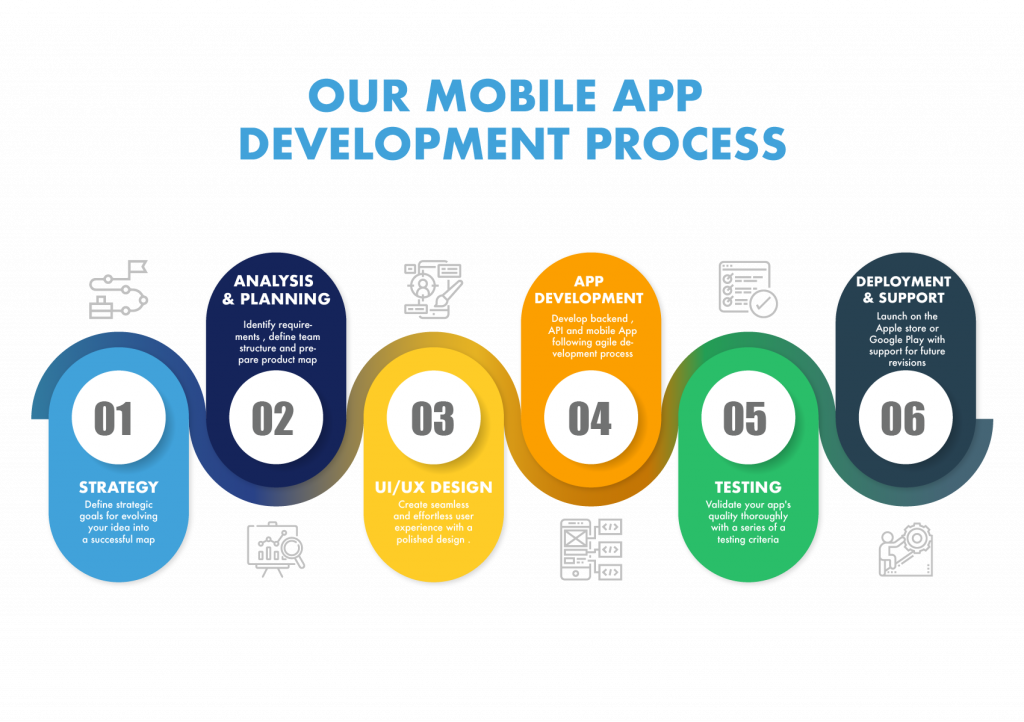In this era, having a mobile app is a must for all businesses. Most people access the internet via mobile devices, and they prefer to have an app rather than searching for a business and
its services in a web browser. From KFC to Ralph Lauren, everyone has their apps.
Let’s discuss the steps involved in developing and running a mobile application.
1. Inception
The first step in the development of any app is inception. This is the step where the client
sits with the app development team and explains to them what he wants from the app. In
this stage, the app developer and the client develop a concrete idea of what the client’s
expectations from the app are and how the app developer will act to help in achieving them.
The end result of this stage is a map that will guide the team of developers down the road to
developing, testing, and deploying the app.
2. Planning the development process
This is the stage when the developer makes a strategy of achieving the results the client
needs from the app. In this stage, the team for developing the app is selected and a map is
developed, which will dictate and help in the next steps of the app development. The
client’s requirements are also translated into the features of the app in this stage. It is
decided in this stage what the user interface of the app would look like on the outside and
what backend features would be needed to run the app.
3. Creating a User Interface
Once it is clear what features the app is going to have, the next step is to develop the
frontend of the app. In this step, the features of the app are converted to the functions of
the app, and a layout of the app is developed. This stage finalizes what the app will look like
to the user. Sometimes the user interface is shown to the client after development, and any
changes they need are then made to the app.
4. Backend Development
This is the original development stage of the app. In this step, the features included in the
Front-end of the app are supported by adding relevant features to the back end. This is
generally the most time consuming and the most complicated step of developing an app.
Any fault or mistake in this step of mobile application development will lead to major errors
and bugs in the functionality of the app.
5. Testing
No app can be final without testing. No matter how good a team has developed an app,
there always are bugs, and they need to be removed before the app is deployed. The app is
sometimes deployed as a beta version for the users to use it so that they can give feedback
on its working. The app is then refined according to the feedback and any errors are
corrected. If that is not an option, the app is tested under all possible scenarios by the
development team, and any bugs encountered are eliminated, and the app is tested again
until there are no further errors in the working of the app.
6. Going Online
After the app has been thoroughly tested and any bugs or errors are eliminated, the app is
made available on Google Play Store or Apple’s App Store, and then can be used by the
users. The developers’ job is not yet over. They have to provide the necessary support
needed to eliminate any errors encountered by the users.
In Summary:
Having a mobile app is necessary to run a business effectively. Developing mobile
applications is a complex and technical task that is usually completed in six major steps. The
cost of the app you need will depend upon the complexity of the app and the features
required to have in the app. The expertise and per hour rate of the app developer will also
be a significant factor in the cost determination. Generally, a simple and basic level app can
cost from $3,000 to $8,000 for development, whereas, if you want to have a complex app
with a number of functions and complex features, it will cost you $50,000 to $150,000. If
you are planning to develop a gaming app, the cost will as per the required functionalities,
and generally falls in the bracket of $10,000 to $250,000. Time could take any where between 3 months and 1 year depending on the complexity of the app.

